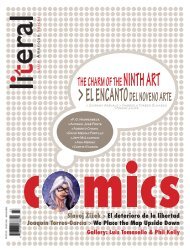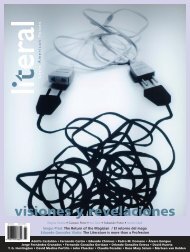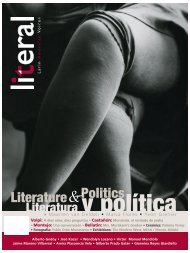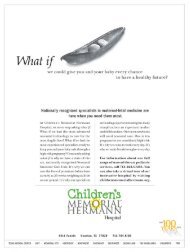Richard Serra - Literal
Richard Serra - Literal
Richard Serra - Literal
Create successful ePaper yourself
Turn your PDF publications into a flip-book with our unique Google optimized e-Paper software.
La escritura será testimonio de la caída de<br />
las hojas, de la vida que se deshidrata cerca del<br />
tronco, una vez parte de su propio cuerpo. Es la<br />
búsqueda por recuperar la esencia de la palabra.<br />
No el uso ordinario de los sonidos, sino el sentido<br />
que reafi rma identidades. Así, Malva Flores abre<br />
sus ojos y reconforta a la raíz que casi muere con<br />
la poda de los sueños: sobrevive al mundo de lo<br />
inmediato, a la emergencia de ser lo que en otro<br />
tiempo fue real; supera la confusión que niega su<br />
verdadera voz, la del poeta capaz de reinventar<br />
las ramas del árbol y sostenerlas en el aire, versantes:<br />
“Me siento nuevamente / en la piedra de<br />
entonces / y veo la mancha azul, la nube / que se<br />
acoda en la cima / tan verde. Tal vez / se encontrará<br />
algún mar / del otro lado.”<br />
Para los lectores, Mudanza del árbol encierra<br />
el signifi cado de ser el origen de la obra; para<br />
su autora es una nueva toma de protesta. Promete<br />
aquí seguir en la disciplina de hacer venir<br />
las palabras, porque el silencio es la muerte de<br />
esa raíz que prevalece en el intento de continuar<br />
creando.<br />
4WENDOLYN LOZANO TOVAR<br />
C. M. Mayo: Miraculous Air,<br />
Milkweed, Canada, 2007.<br />
“I will share with you my oasis<br />
the perfumed land of the south”.<br />
FERNANDO JORDÁN<br />
Christopher Ondaatje said<br />
that travel can occur in two dimensions: inward, in<br />
the mind and spirit through reading, investigation<br />
and contemplation, and physically, which allows<br />
us to discover new cultures through the displacement<br />
of the body. In Miraculous Air, C. M. Mayo<br />
journeys through both dimensions in her expeditions<br />
throughout the Baja California peninsula,<br />
with all the physical vigor one needs to trot over<br />
deserts and mountains along thousands of miles<br />
surrounded by the Pacifi c Ocean and the Sea of<br />
Cortés, and still her spirit voyages, with photographic<br />
patience, contemplates without settling<br />
with what is observed. She wants to absorb it all:<br />
unrepeatable experiences and landscapes that no<br />
one else is to see with the same eyes.<br />
Even though I knew I wouldn’t fi nd the same<br />
images that C. M. Mayo captured, I had the impulse<br />
to go to Baja California, following a minimal<br />
portion of the author’s route, from the “end<br />
of the world”—as the Baja Californians call the<br />
promontory of the Mexican peninsula— to Todos<br />
Santos. In this parallel trip, resonating through<br />
the places that surprised Mayo the most, I gathered<br />
traces of the author left behind in a land of<br />
metaphors. I knew I would see everything differently<br />
just as Cuernavaca will never be the same<br />
as Malcom Lowry’s Under the Volcano, although<br />
lovers might still linger in the Jardín Borda or<br />
just as Comala is not Juan Rulfo´s—even though<br />
its inhabitants might swear they hear a horse’s<br />
hooves in the drowsiness of dog days. Mayo’s<br />
landscapes wove their own stories. As Paul Theroux<br />
states “fi ction is a journey towards the interior”,<br />
the narrative of Miraculous Air, constitutes<br />
an internal perception of reality.<br />
It had been like living in a novel, one person<br />
leading to another, suspense, surprise—always<br />
the surprise. As John Steinbeck wrote: “We do<br />
not take a trip; a trip takes us.“<br />
Landscaper of writing, Mayo portrays a yellow<br />
dragon fruit that unfolds its arms like crazed tentacles<br />
in San Quintín, a cetaceous desert on the<br />
way to Mulegé that could pass as tundra, glowing<br />
lagoons, teasels like giants in the canyon of<br />
La Tinajita. But the human soul is Mayo’s bestoutlined<br />
landscape in this series of explorations.<br />
Mayo is driven to “watch the whale-watchers,<br />
the expatriate artists in Todos Santos, the inhabitants<br />
of towns and missions; observation that<br />
unfurls into surprising stories. As she would have<br />
conveyed to her Economics students, the experiences<br />
of people are the fundamental structure of<br />
economic theory. Mayo enters border maquiladoras,<br />
chicken farms or tomato fi elds to listen to the<br />
voices others don’t pay attention to:<br />
It was the stories of the people associated with<br />
them that mattered—small, sad stories perhaps,<br />
but stories nonetheless, each one opening like a<br />
bud into a many-petaled fl ower: more stories. A<br />
thousand and one stories.<br />
Sure that people give meaning to the places she<br />
describes, Mayo interviews, take notes and pictures.<br />
Her account is not satisfi ed with the testimony<br />
of Professor Agúndez on the murder of<br />
Luis Donaldo Colosio. Mayo sways, crosses the<br />
Tijuana border in a red Oldsmobile and reaches<br />
Lomas Taurinas if only to ask more questions.<br />
Miraculous Air depicts the other Mexico as<br />
a refl ection of itself: a country permeated by<br />
economic imperialism, corruption and poverty; a<br />
privileged geography where the desert and sea<br />
hold an amorous relationship of harmony, a contradiction<br />
in which everyone wants to stay. Fishermen,<br />
artists, oceanographers from other latitudes<br />
want to stay where the whales let themselves be<br />
touched, where vineyards absorb the best of the<br />
earth just as C. M. Mayo also takes the best from<br />
Baja California and disperses it in a miraculous air<br />
because she knows the secret of the oasis, the<br />
perfume of the earth and the permanent desire<br />
for rain, reside within.<br />
4MARTHA BÁTIZ ZUK<br />
Marina Nemat: Prisoner of<br />
Tehran, Simon and Schuster,<br />
New York, 2007.<br />
El libro Prisoner of Tehran<br />
acaba de salir a la venta simultáneamente<br />
en Canadá<br />
(editorial Penguin), Estados<br />
Unidos (Simon and Schuster) e Inglaterra (John<br />
Murray). Los derechos de publicación se han vendido<br />
a diecisiete países en total, y aparecerán versiones<br />
en casi igual número de idiomas alrededor<br />
del mundo. Espasa Calpe tendrá lista la edición<br />
en español a fi nales de este verano. Prisoner of<br />
Tehran es un libro autobiográfi co en el que Nemat<br />
narra su infancia y adolescencia en Teherán,<br />
la forma en que vivió la revolución islámica que<br />
derrocó al Shah e instauró en el poder al Ayatollah<br />
Khomeini, así como su arresto y encarcelamiento<br />
en la prisión de Evín, la más temida de<br />
aquella nación.<br />
Marina tenía dieciséis años cuando la llevaron<br />
presa. La mayor parte de sus compañeras de<br />
encierro tenían su misma edad. Ella fue de las<br />
pocas afortunadas que vivieron para contar lo<br />
que sucedía (y sigue sucediendo) en Evín. Sin embargo,<br />
tuvieron que pasar dieciocho años desde<br />
su liberación para que pudiera por fi n romper el<br />
silencio e iniciar la lucha que ahora emprende,<br />
para dirigir la mirada del mundo hacia las atrocidades<br />
que comete el régimen fundamentalista<br />
musulmán de su país.<br />
Marina Nemat pertenece a la minoría católica<br />
que vivía en Teherán en tiempos del Shah. Sus<br />
abuelos, nacidos en Rusia, llegaron para trabajar<br />
en la construcción de uno de los palacios reales<br />
de Teherán a principios del siglo XX. Estaban ahí<br />
cuando surgió la revolución bolchevique, y decidieron<br />
quedarse para escapar del comunismo. La<br />
infancia de Marina transcurrió entre la vida en Te-<br />
OTOÑO, 2007 • LITERAL. VOCES LATINOAMERICANAS 3 51






